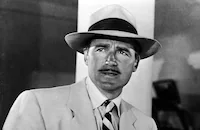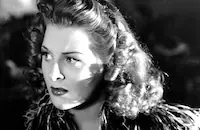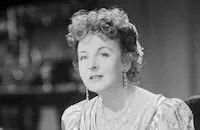The Wolf Man

Brief Synopsis
Cast & Crew
George Waggner
Claude Rains
Warren William
Ralph Bellamy
Patric Knowles
Bela Lugosi
Film Details
Technical Specs

Synopsis
Lawrence Talbot returns to his family estate in the English countryside after an eighteen-year absence in America and is greeted by his father, Sir John Talbot. While Larry offers his regrets over the recent death of his older brother John in a hunting accident, his father apologizes for neglecting Larry for years, and the two resolve to start their relationship anew. Soon thereafter, Larry puts together his father's new telescope and spies upon the beautiful Gwen Conliffe. He then goes into town and meets Gwen at her father's store. There, Larry buys a cane decorated with a wolf's head and a pentagram, which Gwen explains is the sign of the werewolf. Later, she agrees to go with Larry to visit a nearby gypsy camp, but only with her friend, Jenny Williams, as chaperon. While reading her fortune, Bela the gypsy sees the sign of the werewolf on Jenny's palm. Jenny is soon attacked by a wolf, and despite Larry's efforts to rescue her, she is killed, along with the animal. Back at Talbot Castle, Larry is questioned by his old friend, Colonel Paul Montford, the local constable, who tells him that Bela has also been murdered and that Larry's cane was found nearby. In order to prove his innocence, Larry attempts to show Montford where he was bitten by the wolf, only to discover that his wound has disappeared. Later, Larry returns to the gypsy camp, accompanied by Gwen and her fiancé, Frank Andrews, the game keeper for the Talbot estate. There, Larry meets Maleva, Bela's mother, who tells him that her son was a werewolf, and that, having been bitten by him, he too is now a werewolf. Back at Talbot Castle, Larry watches in horror as he slowly transforms into a werewolf. That night, he attacks and kills Richardson, a grave digger. Montford and Dr. Lloyd arrive at the murder scene and find wolf tracks near the murdered body. That morning, Larry wakes to find wolf tracks leading to his bed. He asks his father about the legend of the werewolf, who tells him it is about the good and evil in a man's soul. Later, Montford and Frank set traps for the wolf and the transformed Larry steps into one. After watching him transform back into a man, Maleva releases the confused Larry. Back in town, Larry awakens Gwen and tells her that he is leaving. She offers to go with him, but after seeing the mark of the werewolf on her hand, he refuses. Larry then tries to tell all to his father, but Sir John simply thinks that his son is insane. As a precaution, however, Sir John agrees to tie Larry to a chair and lock him in his room. As his father leaves, Larry asks Sir John to take the silver cane with him. As the hunters take their places in the foggy countryside, Sir John sees Maleva, who tells him he is safe while possessing the cane. Gwen then arrives in search of Larry, and goes into the woods despite Maleva's warnings. As the werewolf attacks her, Sir John arrives and strikes it with the cane. Sir John kills the animal, then watches with Maleva as it transforms back into Larry. As the others arrive, Montford surmises that the wolf attacked Gwen, and Larry must have been killed saving her. Knowing the truth, however, Gwen collapses into Frank's arms.

Director

George Waggner
Cast

Claude Rains

Warren William

Ralph Bellamy

Patric Knowles

Bela Lugosi

Maria Ouspenskaya

Evelyn Ankers

J. M. Kerrigan

Fay Helm
Forrester Harvey

Lon Chaney [jr.]
Leyland Hodgson
Kurt Katch

Doris Lloyd
Olaf Hytten
Harry Stubbs
Tom Stevenson
Eric Wilton

Harry Cording
Ernie Stanton
Ottola Nesmith
Connie Leon
La Riana
Jessie Arnold
Caroline Cooke
Margaret Fealy
Crew
Robert Boyle
Bernard B. Brown
R. A. Gausman
Vernon Keays
Ted Kent
Joe Lapis
Jack Otterson
Jack P. Pierce
Charles Previn
Curt Siodmak
Joseph Valentine
George Waggner
Vera West

Photo Collections
Videos
Movie Clip



Trailer
Hosted Intro
Film Details
Technical Specs

Articles
The Wolf Man
Like Universal's earlier exploration of lycanthropy, Werewolf of London (1935), Waggner's film drew upon European folklore and legends for inspiration and screenwriter Curt Siodmak fashioned an increasingly paranoid narrative around an American, Larry Talbot (Lon Chaney, Jr.), returning to his father's estate in England after an eighteen-year absence. Shortly after Larry's return, he accompanies Gwen Conliffe (Evelyn Ankers) and her girlfriend Jenny (Fay Helm) to a gypsy fair deep in the woods. The evening ends in a horrific incident - Jenny is killed by a wolf and Larry is badly bitten while trying to save her - but the worst is yet to come. During the next full moon, Larry falls prey to a terrible curse, one which the gypsy fortune-teller foretold.
Lon Chaney, Jr., son of the famous silent actor who specialized in grotesque characters and masochistic melodramas, was not yet known as a horror film actor when he was offered the lead role in The Wolf Man. Previously he had enjoyed some critical success as the mentally-challenged Lennie in both the stage play and the 1939 film version of John Steinbeck's Of Mice and Men but it wasn't until he starred in Man Made Monster (1941) for director George Waggner that he began to gravitate toward horror roles. Initially he was up for the lead in Universal's remake of Phantom of the Opera (which wasn't released until 1943) but Claude Rains won that part and Chaney ended up making Man Made Monster, paving the way for what would become his most famous role.
Unlike Henry Hull in Werewolf of London, Chaney was willing to subject himself to long, grueling hours in a makeup chair while Universal's expert in these matters, Jack Pierce, meticulously added yak hair, fangs, a rubber snout and other uncomfortable features to Chaney's face and body. The actor didn't exactly enjoy the process and once complained, "What gets me is after work when I'm hot and itchy and tired, and after I've got to sit in that chair for forty-five minutes while Pierce just about kills me, ripping off the stuff he put on me in the morning."
The filming of The Wolf Man also wasn't any picnic for co-star Evelyn Ankers who had difficulty working with Chaney. Already peeved at Ankers because she was given his dressing room (the studio was punishing him for vandalizing studio property while drunk), the actor would constantly irritate her, nicknaming her "Shankers" while playing juvenile, practical jokes; he liked to sneak up on her in full makeup and scare her. Even more troublesome than Chaney's behavior was the thick, chemical fog that permeated the set daily and made breathing difficult. For one scene, Ankers had to faint and fall to the misty ground but the fog fumes were so strong she passed out. Unnoticed by the director and crew who were concentrating on another aspect of the scene, she remained there unnoticed until a studio technician began breaking down the set. Ankers also suffered a bad scare when a 600-pound bear (his sequence in the film was later cut) escaped its trainer and chased the actress up a ladder where she was pulled to safety by an electrician.
Other interesting behind-the-scenes trivia: The film's original title was Destiny; Bela Lugosi had hoped to play the title role in The Wolf Man but ended up fifth billed as "Bela the gypsy"; Dick Foran was originally slated for the role which Patric Knowles ended up playing; in earlier script treatments, the werewolf was rarely glimpsed and Larry Talbot was not the son of an English nobleman but an American mechanic; the atmospheric sets were designed by Jack Otterson who created the German Expressionist look of Son of Frankenstein (1939).
The Wolf Man opened just two days after the bombing of Pearl Harbor and despite mixed reviews from the critics turned out to be a surprise hit for Universal. Over the years the film's reputation has steadily improved with horror buffs and film scholars noticing the strains of Greek tragedy (the grim trajectory of Talbot's relationship with his domineering father) and old world superstitions that run throughout the movie. The Wolf Man, more than Werewolf of London, is also responsible for establishing the mythology and on-screen representation of werewolf lore that followed in subsequent imitators from the pentagrams to the wolfbane to the full moon transformation scenes. In the end, though, The Wolf Man is Lon Chaney, Jr.'s finest hour, and it's certainly Maria Ouspenskaya's most memorable role as well. As Maleva, the gypsy fortune-teller who shares Talbot's pain, Ouspenskaya's soothing recitations still haunt many a young viewer who saw the film at an impressionable age: "The way you walk was thorny through no fault of your own, but as the rain enters the soil the river enters the sea, so tears run to a predestined end. Your suffering is over. Now you will find peace for eternity."
Producer: Jack J. Gross, George Waggner
Director: George Waggner
Screenplay: Curt Siodmak
Cinematography: Joseph A. Valentine
Film Editing: Ted Kent
Art Direction: Jack Otterson
Music: Charles Previn, Hans J. Salter, Frank Skinner
Cast: Claude Rains (Sir John Talbot), Warren William (Dr. Lloyd), Ralph Bellamy (Col. Paul Montford), Patric Knowles (Frank Andrews), Bela Lugosi (Bela), Maria Ouspenskaya (Maleva).
BW-70m. Closed captioning.
by Jeff Stafford

The Wolf Man
Quotes
Whoever is bitten by a werewolf and lives becomes a werewolf himself.- Maleva
Ah, quit handing me that. You're just wasting your time.- Larry Talbot
The wolf bit you, didn't it?- Maleva
Yeah. Yeah it did!- Larry Talbot
Even a man who is pure in heart and says his prayers by night, may become a wolf when the wolfbane blooms and the autumn moon is bright.- Sir John Talbot
All astronomers are amateurs. When it comes to the heavens, there's only one professional.- Sir John Talbot
The way you walk was thorny through no fault of your own, but as the rain enters the soil the river enters the sea, so tears run to a predestined end. Your suffering is over. Now you will find peace for eternity.- Maleva
The way you walk was thorny through no fault of your own, but as the rain enters the soil the river enters the sea, so tears run to a predestined end. Your suffering is over, Bela my son. Now you will find peace.- Maleva
Trivia
Larry Talbot's brother's name was John.
Larry had been away 18 years working on Mt. Wilson Observatory in California.
The first transformation takes place with Talbot in an undershirt (although he is fully dressed in a dark shirt once on the prowl). Only the feet transform on screen in six lapse dissolves. In the second transformation there are eleven shots -- again of feet only. The third transformation features 17 face shots in a continuous dissolve.
The Wolfman battled a bear in one scene but unfortunately the bear ran away during filming. What few scenes were filmed were put into the theatrical trailer.
"Even a man who is pure at heart, and says his prayers by night, may become a wolf when the wolfbane blooms and the autumn moon is bright." This memorable quote has been listed in some sources as an authentic Gypsy or Eastern European folk saying. Writer Curt Siodmak admits that he simply made it up.
Notes
The working title of this film was Destiny. Although Hollywood Reporter news items and production charts include Dick Foran in the cast, he did not appear in the released film. According to Variety, this was the first film in which actor Lon Chaney dropped the "Jr." from his name. Universal press materials claim that makeup artist Jack Pierce spent five years researching werewolves and worked for five months to find the correct combination of rubber, color and hair to create the character of "The Wolf Man." Modern sources add the following names to the crew credits: Music H. J. Salter and Frank Skinner; and Special Effects John P. Fulton. Modern sources add to the cast: Eddie Polo (Churchgoer) and Gibson Gowland (Villager). Modern sources also state that this was Universal's highest grossing film of 1941. The success of The Wolf Man led to the creation of a new Universal horror series. Chaney played the role of Larry Talbot in four more films, ending with the 1948 horror comedy Abbott and Costello Meet Frankenstein (see entry above.)
Other werewolf films include the 1913 Bison short film The Werewolf; the 1935 Universal production Werewolf of London, starring Henry Hull and Warner Oland and directed by Stuart Walker (see AFI Catalog of Feature Films, 1931-40; F3.4993); Twentieth Century-Fox's 1942 production The Undying Monster, directed by John Brahm and starring James Ellison and Heather Angel (see entry above); the 1944 Columbia feature Cry of the Werewolf, directed by Henry Levin and starring Nina Foch and Stephen Crane (see entry above); the 1956 Columbia film The Werewolf, directed by Fred F. Sears and starring Steven Ritch and Don Megowan; American International Pictures' 1957 film I Was a Teenage Werewolf, directed by Gene Fowler and starring Michael Landon and Yvonne Lime; the 1960 Hammer production The Curse of the Werewolf, directed by Terence Fisher and starring Oliver Reed and Clifford Evans; the 1961 Austrian-Italian co-production Werewolf in a Girl's Dormitory, directed by Richard Benson (Paolo Heusch) and starring Carl Schell and Barbara Lass; two 1973 films: The Boy Who Cried Werewolf, directed by Nathan Juran and starring Kerwin Mathews and Elaine Devry and The Werewolf of Washington, directed by Milton Moses Ginsberg and starring Dean Stockwell and Biff McGuire; the British 1975 production Legend of the Werewolf, directed by Freddie Francis and starring Peter Cushing and Ron Moody; Universal's 1981 An American Werewolf in London, directed by John Landis and starring David Naughton, Jenny Agutter and Griffin Dunne and it's 1997 sequel An American Werewolf in Paris, directed by Anthony Waller and starring Tom Everett Scott and Julie Delpy; Avco Embassy's 1981 The Howling, directed by Joe Dante and starring Dee Wallace and Patrick Macnee (which was followed by five sequels); and Atlantic's 1985 Teen Wolf, directed by Rod Daniel and starring Michael J. Fox and it's 1987 sequal Teen Wolf Too, directed by Christopher Leitch and starring Jason Bateman.

Miscellaneous Notes
Released in United States 1941
Released in United States on Video April 7, 1988
Re-released in United States on Video August 3, 1994
Re-released in United States on Video August 6, 1996
Released in United States 1998
Shown at Film Forum Universal Horror Festival in New York City October 30 - November 12, 1998.
Formerly distributed by MCA Home Video.
Released in United States 1941
Released in United States on Video April 7, 1988
Re-released in United States on Video August 3, 1994
Re-released in United States on Video August 6, 1996
Released in United States 1998 (Shown at Film Forum Universal Horror Festival in New York City October 30 - November 12, 1998.)















